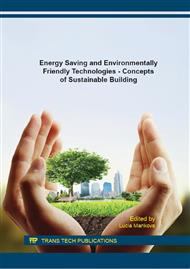p.519
p.527
p.536
p.544
p.552
p.563
p.571
p.579
p.589
Usage of Raspberry Pi for Temperature and Relative Humidity Measurements and Comparison with HAM Simulation
Abstract:
The temperature and relative humidity measurement in building physics needs special equipment which is often expensive and not available for young researchers. Several programmable platforms are available. This article describes the low-cost solution of temperature and relative humidity measurement using combined Digital Humidity/Temperature sensors and Raspberry Pi as the datalogger. Five lightweight timber frame wall fragments with various thermal insulations and outdoor coating colors were exposed to the real outdoor boundary climate conditions. The indoor boundary conditions were secured as constant. The results of measurement using low cost sensors were compared to values obtained by commercially available thermocouples for scientific use and non-steady HAM simulation in WUFI software.
Info:
Periodical:
Pages:
552-559
Citation:
Online since:
January 2016
Authors:
Price:
Сopyright:
© 2016 Trans Tech Publications Ltd. All Rights Reserved
Share:
Citation:


